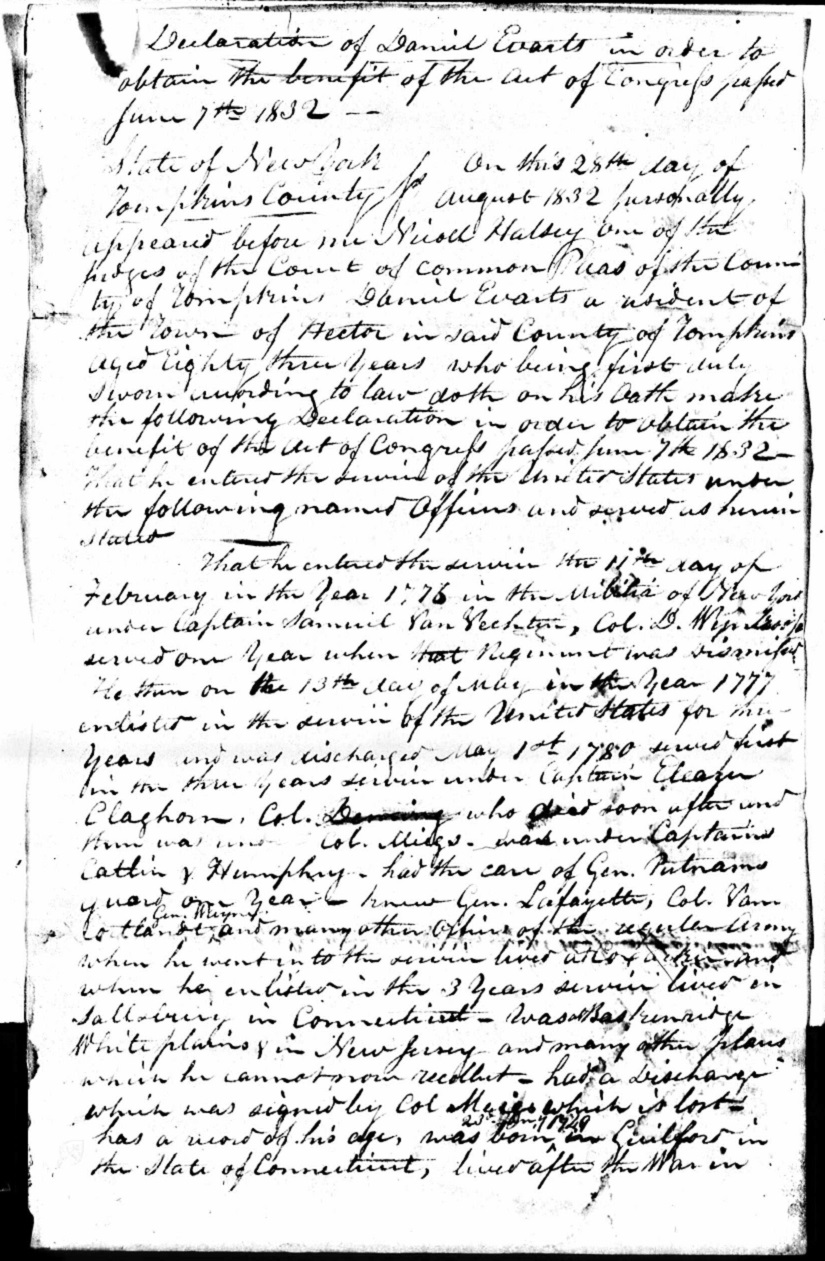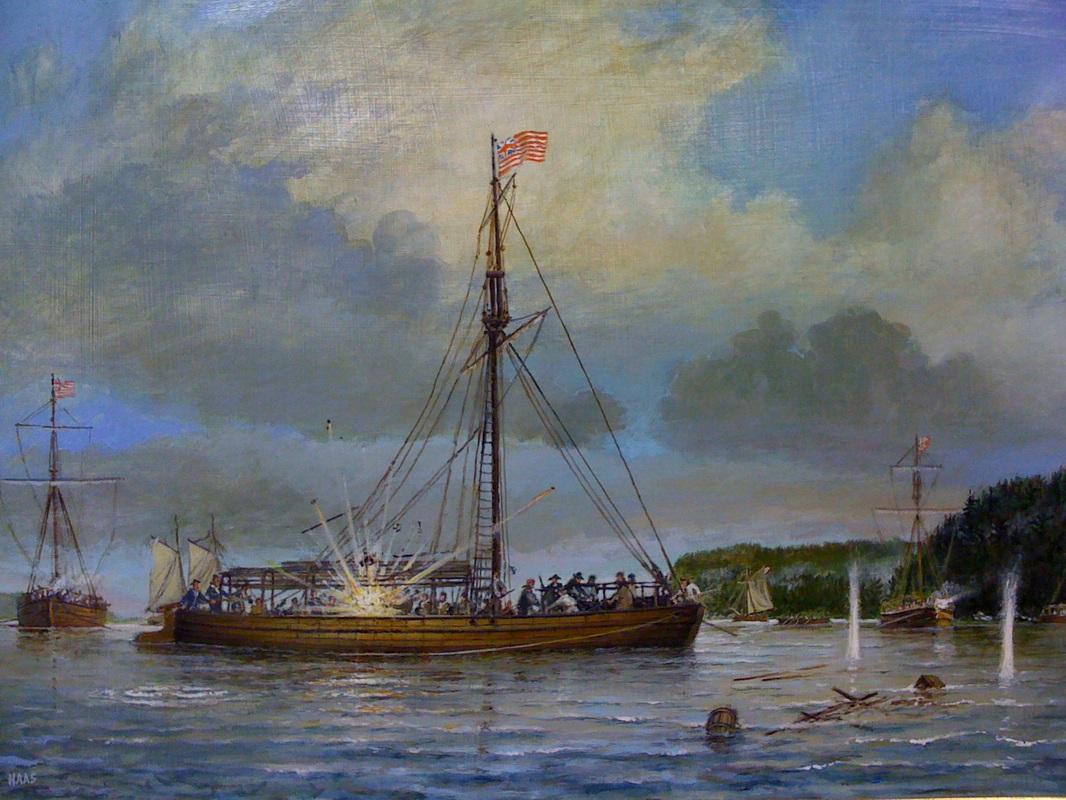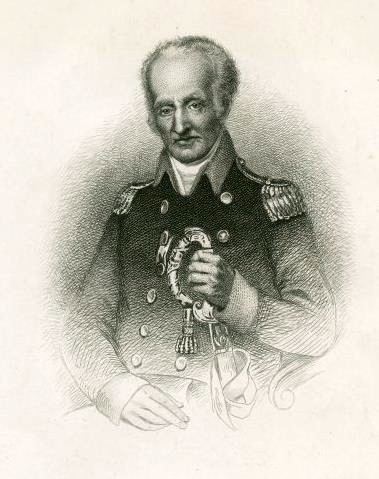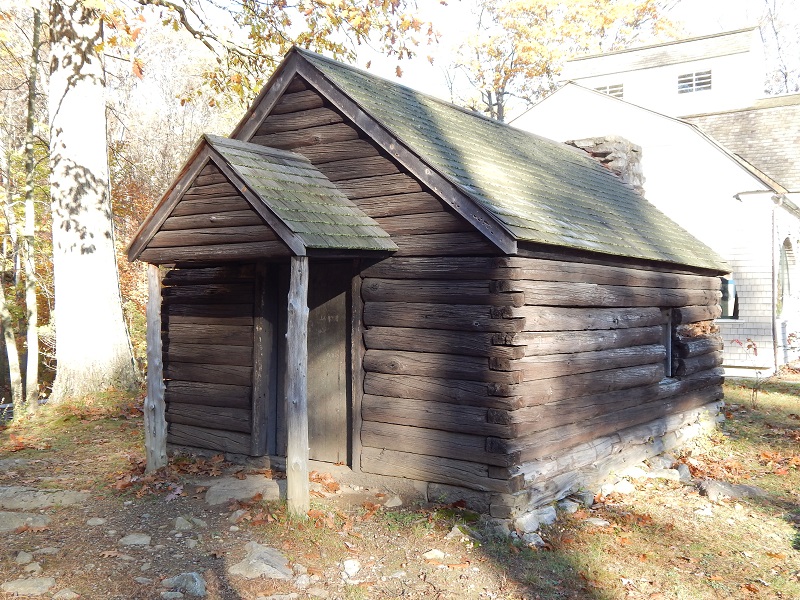By Don Krüger
July 2017
On August 28, 1832, my 4th great-grandfather, Daniel Everts (1749-1833), made a declaration under oath before Judge Nicoll Halsey of Tompkins County, NY, in which he described his own military service in the Continental Army of the United States during the Revolutionary War. The next few lines are my transcription of the self-declared service portion of Daniel Everts’ statement taken from a digitized copy of the original document that is available through Ancestry.com.
—–
“That he entered the Service the 11th day of February in the year 1776 in the Militia of New York under Captain Samuel Van Vechten, Col. D. Wynkoop. Served one year when that regiment was dismantled. When he went into the service lived at Coxsackie and when he enlisted in the 3 years service lived in Salisbury in Connecticut. He then on the 13th day of May in the year 1777 enlisted in the service of the United States for three years and was discharged May 1st 1780. Served first of his three years service under Captain Eleazer Claghorn, Col. Douglas who died soon afterward. Then was under Col Miegs. Was under Captain Caitlin and Humphreys. Had the care of Gen. Putnam’s guard one year. Knew Gen. Lafayette, Col Van Cortlandt, Gen. Wayne, and many other officers of the regular Army. Was at Basking Ridge, White Plains in New Jersey and many other places which he cannot now recollect. Had a discharge which was signed by Col Miegs which is lost.”
—–
I got such a thrill when I saw that Daniel Everts said that he had been in White Plains during the Revolution. My childhood home was nearby and I remember passing by Washington’s Headquarters many times. Our home in Elmsford was only about five miles away. I began to wonder if Daniel had ever been to those headquarters? Perhaps at the time when Lafayette was there! Many of the paths and roads my ancestor traveled during the Revolution became the roads where I would learn to drive a car. I became curious. Where else may he have been during the war? What battles had he been involved with? What did he do during the war?
I took information from his pension application statement and placed it into a timeline. Through Fold3.com and Ancestry.com I was able to find sixteen of Daniel Everts’ monthly muster records. These were dated from May 1778 until his discharge in May 1780 and indicate specifically where he was and what his assignments were for a large portion of the last two years of his service to the United States.
—–
“That he entered the Service the 11th day of February in the year 1776 in the Militia of New York under Captain Samuel Van Vechten, Col. D. Wynkoop. Served one year when that regiment was dismantled. When he went into the service lived at Coxsackie and when he enlisted in the 3 years service lived in Salisbury in Connecticut.”
—–
April 11, 1776 – Daniel Everts is Listed with the New York Militia as Ensign.
On April 11, 1776, only a few months after his enlistment with the New York Militia, Daniel Everts had obtained the rank of Ensign under Captian Samuel Van Vechten. Here is a link to information pertaining to Daniel Everts and Captain Samuel Van Vechten from rootsweb.ancestry.com, which quotes information from Beer’s History of Greene County. The following information appears on a related RootsWeb page citing the same source.
Daniel Evarts, Catskill/Old Coxsackie
An ensign in Capt. Samuel Van Vechten’s Company, Col. Cornelius D. Wynkoop’s Battalion, 11th NY Regt. Enlisted April 11, 1776. (Beer’s History of Greene County, pg 29. Weblink, rootsweb.ancestry.com.)Capt. Samuel Van Vechten, Old Catskill
Born September 28, 1742, the son of Teunis Van Vechten and Judikje Ten Broeck, grandson of Teunis Van Vechten and Cathlyntje Van Petten. Died February 12, 1813. Residence at the time of the Revolution was Leeds. In 1776 he was commissioned a captain in the regiment of infantry of which Anthony Van Bergen was colonel, and almost immediately went into active service. On May 19, he left Albany on horseback, and on the 22nd joined the army, under Schuyler, at Skeensborough. Was officer of the day, and due routine at Ticonderoga, Skeensborough and Fort Edward. Twice he was bearer of dispatches to Albany. Enforced order and discipline among carpenters and boatmen who had assembled from the Hudson and Connecticut to build bateaux (boats) for the defense of Lake Champlain. (Beer’s History of Greene County, pg 92, 443, 444. DAR Records.Weblink, rootsweb.ancestry.com.)
May – July 1776 – Fort Ticonderoga
Daniel Everts was fourth in command of Captain Samuel Van Vechten’s Company at Fort Ticonderoga that was on a mission to repair the fort and build new fortifications nearby. Years of neglect under British rule following the French and Indian War combined with the removal of most of the cannons, and the destruction of the powder store by Ethan Allen and General Knox one year prior had rendered the fort almost useless for its primary purpose.
August and September 1776 – Skeensboro
Van Vechten and his men, many of whom were carpenters who built boats for the fur and lumber trades along the Hudson River, moved several miles south of Fort Ticonderoga to Skenesboro, NY (Whitehall). There they built the “bateau” for Benedict Arnold. The bateau was a popular style of boat in that time era. They were usually 40 to 50 feet in length and 5 to 8 feet wide with a relatively flat bottom. This particular fleet of bateau is considered by some to have been the beginning of the United States Navy.
In the last week of September, Samuel Van Vechten sent a letter to Leonard Bronck in Coxsackie describing some of the living conditions present in Skenesboro:
“…You will best be able to judge. I have this month Past been very much Troubld with the Fevourage every other Day which hes made me very week & Poor: it is the unholesomest Place that Ever was known in this World their hes scarcely been a Men on this Ground for Two or three weeks but what hes head that Disagreeable Distemper or something worse But thank God I have got the Better of it for I have not head it these 4 Days last past & hope it may not lay hould of me again…”
October 11, 1776 – Battle of Valcour Island
It is unknown to me whether or not Daniel Everts was a participant inthe Battle of Valcour Island. The small newly built American fleet under the command of Benedict Arnold was mostly destroyed or captured by the British. The Americans were able to delay the British plans of capturing the upper Hudson River Valley until the following spring.
Winter 1776 – Spring 1777 – Transition
At some point, during this period Daniel Everts changed his residence from Coxsackie, NY to Salisbury, CT, where he had lived for almost all of his formative years. More correctly, his father’s home and tavern were located near the crossroads of Lakeville, CT, a hamlet located just a little south of Salisbury, in Litchfield County.
—–
“…He then on the 13th day of May in the year 1777 enlisted in the service of the United States for three years and was discharged May 1st 1780. Served first of his three years service under Captain Eleazer Claghorn, Col. Douglas who died soon afterward. Then was under Col Miegs.”
—–
May 13, 1777 – Enlistment with the Connecticut 6th
A British raid on a munitions store in Danbury, CT, on April 25, 1777 combined with the inspiring battlefield heroics of Benedict Arnold two days later in the Battle of Ridgefield are among the most likely motivations for Daniel Everts’ enlistment at New Haven for three years with the Connecticut 6th on May 13, 1777.
May 24, 1777 – Meigs Raid of Sag Harbor
The Meigs Raid of Sag Harbor was designed by Brigadier General Samuel Holden Parsons as retribution for the British raid on Danbury a month earlier. In the evening hours of May 23, 1777, 170 men led by Lt. Colonel Return Jonathan Meigs left the Connecticut coast at Sachem Head Harbor, near Guilford, for Long Island. They rowed thirteen whaleboats across Long Island Sound and portaged over the North Fork of Long Island, finally landing near Sag Harbor around daybreak. They silently charged the British with bayonet and defeated Lt. Col. Stephen De Lancey and his men, killing six and capturing the other 70. The Americans then burned 100 tons of hay, 10 transports, and the wharves at Sag Harbor. Taking 90 prisoners with them, the raiding party then made their way back across The Sound to Guilford, CT, landing there near noontime, having completed the 100-mile trip and raid in a little more than 18 hours. The Americans suffered no casualties.
Summer 1777 – Peekskill, NY
After the raid on Sag Harbor the Connecticut 6th rejoined the rest of the Connecticut line in Peekskill, NY where they remained through the summer of 1777.
Winter 1777 – 1778 – West Point
The Connecticut 6th spent the winter months at West Point. There, among the lesser fortifications that were constructed near the main fort, they built Meigs Redoubt which protected West Point against attacks from the south via the Hudson River and nearby shoreline.
—–
“Was under Captain Caitlin and Humphreys. Had the care of Gen. Putnam’s guard one year. Knew Gen. Lafayette, Col Van Cortlandt, Gen. Wayne, and many other officers of the regular Army. Was at Basking Ridge, White Plains in New Jersey and many other places which he cannot now recollect. Had a discharge which was signed by Col Miegs which is lost.”
—–
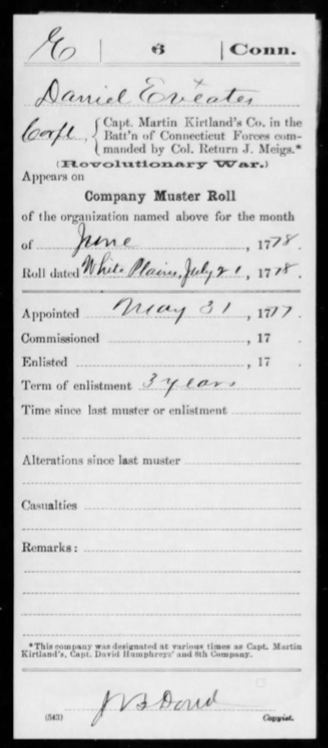 May 1778 – June 21, 1778 – Pickskill – Daniel Everts’ Muster Card
May 1778 – June 21, 1778 – Pickskill – Daniel Everts’ Muster Card
June 1778 – July 21, 1778 – White Plains – Daniel Everts’ Muster Card
Summer 1778 – White Plains
The Connecticut 6th spent the summer of 1778 encamped with the main army under Washington at White Plains not far from the battlefields of 1776. Washington himself arrived in White Plains in mid-July. His headquarters were split between the Elijah Miller House that I was familiar with in North White Plains and the Jacob Purdy house which is located at 60 Park Avenue in White Plains.
It is not difficult to imagine that at some point, a group of soldiers that included Daniel Everts patrolled the roads and paths in White Plains and the roads that led to surrounding communities and other American encampments that existed in the area at the time. Some Generals headquartered themselves in buildings on the Young Estate which today is the site of Westchester Community College. The four corners in Storms Bridge (Elmsford) on the road between Tarrytown and White Plains was of tremendous importance for communications and rendezvous purposes. All are roads that I would come to know two centuries later.
September 15, 1778 – Peekskill
The CT 6th Regiment marched from White Plains to a place that was north of Peekskill and across the Hudson River from West Point and near the towns of Garrison and Cold Spring amid the Hudson Highlands. Washington made his appearance in Garrison on September 19th.
Sept. 1778 – Oct. 3, 1778 – Sick at Salisbury – Daniel Everts’ Muster Card
Oct. 3, 1778 – Nov. 11, 1778 – New Milford – Daniel Everts’ Muster Card
Daniel Everts missed marching from White Plains to Peekskill with the CT 6th in September 1778 as he was on sick leave in his hometown of Salisbury, CT. While the huts were being built in Redding, CT, the regiment set up a temporary winter camp in New Milford, CT.
Winter 1778 – 1779 – Redding
The several regiments that were under the charge of 61-year-old General Israel Putnam, spent the winter of 1778-1779 in Redding, CT — “Connecticut’s Valley Forge.” The Connecticut 2nd made camp in an area that has been preserved as Putnam Memorial State Park. The Connecticut 6th was encamped close by, under similar conditions, near a place that ever since has been called “Gallows Hill.”
Nov. 1778 – Dec. 12, 1778 – Reading – Daniel Everts’ Muster Card
Dec 2, 1778 – Jan 5, 1779 – “On Guard” (no location) – Daniel Everts’ Muster Card
I find that even with the abundance of information that I have pertaining to Daniel Everts’ whereabouts during this period of time, I cannot be certain if indeed he was present or if he witnessed any of the events that occurred in Redding during this winter period.
December 30, 1778 — Mutiny in Redding From the Putnam Memorial State Park website, as told in the diary of Private Joseph P. Martin.
“…The frustrations caused by the deprivations brought to a head the attempted mutiny on the morning of December 30th at Huntington’s camp. The troops had decided on the bold resolve of marching to Hartford, and airing their grievances in person to the Legislature then sitting. The two brigades were plotting their escape when the threat of troop desertion was brought to Putnam’s attention. He, with his usual intrepidity and decision of character, threw himself upon his horse and dashed down the road leading to his camps, never slacking rein until he drew up in the presence of the disaffected troops.”
“My brave lads,” he cried, “whither are you going? Do you intend to desert your officers, and invite the enemy to follow you into the country? Whose cause have you been fighting and suffering so long in-is it not your own? Have you no property, no parents, wives, children? You have behaved like men so far-all the world is full of your praises, and posterity will stand astonished at your deeds; but not if you spoil it all at last.
Don’t you consider how much the country is distressed by the war, and that your officers have not been any better paid than yourselves? But we all expect better times, and that the country will do us ample justice. Let us all stand by one another then, and fight it out like brave soldiers. Think what a shame it would be for Connecticut men to run away from their officers.”
When he had finished this stirring speech, he directed the acting Major of Brigades to give the word for them to march to their regimental parades, and lodge arms, which was done; one soldier only, a ringleader in the affair, was confined to the guard house, from which he attempted to escape, but was shot dead by the sentinel on duty — himself one of the mutineers. Thus ended the affair.
According to the muster records for this time period, Daniel Everts was in camp at Redding and was on general guard duty on December 30th. In all likelihood, when “Old Put” (General Putnam) went to quell the mutiny, he brought with him a certain number of men who were on guard duty at that moment and Daniel Everts may have been one of them.
Jan – Feb 2, 1779 – “On Guard” (no location) – Daniel Everts’ Muster Card
Continued from the Putnam Memorial State Park website:
“…In January, Private Joseph P. Martin related two more uprisings in his camp journal, both were thwarted by regimental officers, but indicate some discontent among the troops still lingered. After that many of the Connecticut troops were placed on patrols at Horseneck, Stamford and Norwalk. Some were sent over to “no-man’s land” in Westchester County and several hundred troops were sent to New London for guard duty and the construction of Fort Griswold.”
Feb – Mar 4, 1779 – “On Command, Norwalk” – Daniel Everts’ Muster Card
According to this muster card, Daniel Everts was one of the men who was sent to Norwalk. It is unclear at what point in time he actually went to the Connecticut Coast but it is probable that it was after the events in early February that led up to the executions on February 16, 1779.
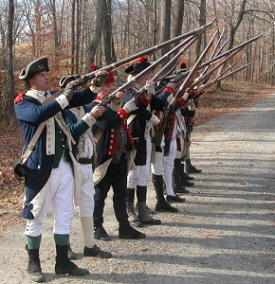
Putnam Park Reenactment
Executions on Gallows Hill — February 16, 1779 — from the Putnam Memorial State Park website history page at http://putnampark.org/park-history/:
“…Putnam was no stranger to deserters and spies. Nothing had so much annoyed Putnam and his officers during the campaigns of the preceding summer on the Hudson than the desertions which had thinned his ranks, and the Tory spies, who frequented his camps, under every variety of pretext, and forthwith conveyed the information thus gathered on the enemy.
To put a stop to this it had been determined that the next offender of either sort (deserter or spy) captured should suffer death as an example. The opportunity to implement this determination soon arrived. Scouts from Putnam’s outposts in Westchester County captured a man lurking within their lines, and as he could give no satisfactory account of himself, he was at once hauled over the borders and into the presence of the Commander-in-Chief. In answer to the commanders queries, the prisoner said that his name was Jones, that he was a Welshman by birth, and had settled in Ridgefield a few years before the war commenced; that he had never faltered in his allegiance to the King, and that at the outbreak of the hostilities he had fled to the British army, and had been made a butcher in the camp; a few weeks before, he had been sent into Westchester County to buy beef for the army, and was in the process of carrying out those orders at the present. He was remanded to the guard house, court-martialed and at once ordered for trial. Putnam had his first example.
On Feb. 4, 1779, Edward Jones was tried at a General Court Martial for going to and serving the enemy, and coming out as a spy. He was found guilty of each and every charge exhibited against him, and according to Law and the Usage’s of Nations was sentenced to suffer Death:
“The General approves the sentence and orders it to be put in execution between the hours of ten and eleven A.M. by hanging him by the neck till he be dead.”
Two days after another General Court Martial was held for a similar offence: on Feb. 6, 1779, John Smith of the 1st Connecticut Regiment, was tried at a General Court Martial for desertion and attempting to go to the enemy, found guilty, and further persisting in saying that he will go to the enemy if ever he has an opportunity.
“The General approves the sentence and orders that it be put in execution between the hours of ten and twelve A.M. for him to be shot to death”
General Putnam having two prisoners under the sentence of death determined to execute them both at once, or as he expressed it, “to make a double job of it,” and at the same time make the spectacle as terrible and impressive as the circumstances demanded.
The scene which took place at the execution of these men on February 16 was described as shocking and bloody, it occurred on a lofty hill (known to this day as Gallows Hill) dominating the valley between the three camps. The instrument of Edward Jones’ death was erected approximately twenty feet from the ground atop the hill’s highest pinnacle. Jones was ordered to ascend the ladder, with the rope around his neck and attached to the cross beam of the gallows. When he had reached the top rung General Putnam ordered him to jump from the ladder.
‘No General Putnam,’ said Jones, ‘I am innocent of the crime laid to my charge; I shall not do it.’
Putnam drawing his sword, compelled the hangmen at sword’s point, that his orders be obeyed and if Jones would not jump, that the ladder be over-turned to complete the act. It was and he perished.
The soldier that was to be shot for desertion was but a youth of sixteen or seventeen years of age. The Rev. Nathaniel Bartlett, who was pastor of the Congregational Church in Redding for a period of fifty years, officiated as chaplain to the encampment during that winter, and was present at the execution. He interceded with General Putnam to defer the execution of Smith until Washington could be consulted- for reason the offender was a youth; but the commander assured him that a reprieve could not be granted.
John Smith was described as “extremely weak and fainting” as he was led by Poor’s Brigade Chaplain, the Rev. Dr. Evans, approximately 200 yards from the gallows to the place he was to be shot.
Putnam gave the order and three balls were shot through his breast: he fell on his face, but immediately turned over on his back; a soldier then advanced, and putting the muzzle of his gun near the convulsive body of the youth, discharged its contents into his forehead. The body was then placed in a coffin; the final discharge had been fired so near to the body that it had set the boy’s clothing on fire, and continued burning while each and every soldier present was ordered to march past the coffin and observe Smith’s mangled remains; an officer with a drawn sword stood by to ensure they complied.
It was indeed a grisly scene, and many have questioned the accuracy of the accounts published about it because it seems almost too ghastly. But it should be said that: boldness, firmness, promptness, decisiveness- were the chief elements of General Israel Putnam’s character, and at this particular crisis all were needed. There was disaffection and insubordination in the army, as has been noted. Desertions were frequent, and spying by the Tories was almost openly practiced. To put a stop to these practices it was vitally necessary to the safety of the army, to see that these sentences were carried into effect. If the executions were bungling done, the fault was with the executioners, and not with the General.”

“Putnam Cottage”
Located on Rte. 1 in Greenwich, CT, Across the street from Christ Church Episcopal.
February 26, 1779 – General Putnam’s Escape from the British at Horseneck
The following is an account of the Horseneck escape as described on page 165 in Colonel David Humphreys’ book, “The Life and Heroic Exploits of Israel Putnam Major-General in the Revolutionary War.” According to Daniel Everts’ pension application statement, he served under Humphreys while the then Captain was General Israel Putnam’s Aide-de-Camp. When Putnam retired in the spring of 1780, Humphreys was promoted to Colonel and replaced Alexander Hamilton as one of General George Washington’s Aides-de-Camp.
“About the middle of winter, while General Putnam was on a visit to his out-post at Horseneck, he found Governor Tryon advancing upon that town with a corps of fifteen hundred men. To oppose these, General Putnam had only a picket of one hundred and fifty men, and two iron field-pieces, without horses or drag-ropes. He, however, planted his cannon on the high ground, by the meeting-house, and retarded their approach by firing several times, until, perceiving the horse (supported by the infantry) about to charge, he ordered the picket to provide for their safety, by retiring to a swamp inaccessible to horse, and secured his own, by plunging down the steep precipice at the church upon a full trot. This precipice is so steep, where he descended, as to have artificial stairs, composed of nearly one hundred stone steps, for the accommodation of foot passengers. There the dragoons, who were but a sword’s length from him, stopped short; for the declivity was so abrupt, that they ventured not to follow; and, before they could gain the valley, by going round the brow of the hill in the ordinary road, he was far enough beyond their reach. He continued his routs, unmolested, to Stamford; whence, having strengthened his picket by the junction of some militia, he came back again, and in turn, pursued Governor Tryon in his retreat. As he rode down the precipice, one ball, of the many fired at him, went through his beaver: but Governor Tryon, by way of compensation for spoiling his hat, sent him, soon afterwards, as a present, a complete suit of clothes.”
Mar – Apr 1, 1779 – “On Command, Norwalk” – Daniel Everts Muster Card
March 30, 1779 – Daniel Evarts marries Mary Rowland?
An entry in Reverend Nathaniel Bartlett’s ledger reads, “March 30, 1779. I joined together in marriage Daniel Evarts, a soldier in the army, and Mary Rowland.” Rev. Bartlett was pastor of the Congregational Church in Redding for a period of fifty years and served as Chaplain to the men positioned in Redding that winter.
Looking at these records it appears as though Daniel Everts was on command in Norwalk, CT from about the middle of February, 1779, until very late in March when he returned to Redding. And was married to Mary Rowland? The only problem with this is that there is no mention of a “Mary Rowland” in the family histories of Daniel Everts. According to Everts Family Bible transcriptions in The Ancestral Lines of Chester Everts Howell, by Jesse Howell Finch, p. 41, Daniel Everts was married first to Charity Van Deusen in 1767, second to Mary “Molly” Hurd (my 5th great-grandmother) in 1780, and third to Abigail Hotchkiss in 1819.
May – Jun 16, 1779 – “On Put’s Guard” (no location) – Daniel Everts’ Muster Card
Jun – July 2, 1779 – “On Put’s Guard” (no location) – Daniel Everts’ Muster Card
“On Put’s Guard” is specific information for what Daniel Everts’ responsibilities were for the months of May and June 1779. Though his own statement indicates that he, “Had the care of Gen. Putnam’s guard one year,” there is evidence that he was “On Put’s Guard” for two months. Perhaps Daniel Everts, who never rose above the rank of corporal, might have augmented his story a bit in hopes of receiving the pension of one who had achieved the rank of Sargeant-of-the-Guard.
Daniel Everts did have the honor of serving on General Israel Putnam’s Safety Guard in some capacity. It is probable that Putnam’s Safety Guard or “Life Guard” was modeled after that of George Washington’s who established his Life Guard in 1776. Washington’s unit was created by selecting four men from each Continental Army regiment present at the siege of Boston. Washington’s general order on 11 March 1776 outlined the type of men he hoped to recruit:
“The General being desirous of selecting a particular number of men, as a Guard for himself, and baggage, The Colonel, or commanding Officer, of each of the established Regiments, (the Artillery and Rifflemen excepted) will furnish him with four, that the number wanted may be chosen out of them. His Excellency depends upon the Colonels for good Men, such as they can recommend for their sobriety, honesty, and good behaviour; he wishes them to be from five feet, eight Inches high, to five feet, ten Inches; handsomely and well made, and as there is nothing in his eyes more desirable, than Cleanliness in a Soldier, he desires that particular attention may be made, in the choice of such men, as are neat, and spruce. They are all to be at Head Quarters to morrow precisely at twelve, at noon, when the Number wanted will be fixed upon. The General neither wants men with uniforms, or arms, nor does he desire any man to be sent to him, that is not perfectly willing, and desirous, of being of this guard. They should be drill’d men.“
General Putnam’s Life Guard would have acted in a similar fashion as that of today’s Secret Service. The guard would accompany General Putnam everywhere he went. They were responsible for the protection and movement of necessary documents and cash — “Baggage.” The sentries posted outside and inside the General’s headquarters would be members of his Life Guard.
—–
“…Was under Captain Caitlin and Humphreys. Had the care of Gen. Putnam’s guard one year. Knew Gen. Lafayette, Col Van Cortlandt, Gen. Wayne, and many other officers of the regular Army.”
—–
It is with probable certainty that in this position Daniel Everts would have been known to many of the Generals and other officers who would have been involved with the planning and execution of the re-taking of Stony Point on July 16, 1779 including; General Lafayette, Colonel Van Cortlandt, and General “Mad Dog” Anthony Wayne.
July – Aug 2, 1779 – “On Command, N. Windsor” – Daniel Everts Muster Card
July 16, 1779 – Battle of Stony Point
The Battle of Stony Point was a well planned night time attack by a specially selected group of the Continental Army under the command of Brigadier General Anthony Wayne. Colonel Return J. Meigs and the Connecticut 6th made up the 3rd regiment of light infantry. Since Daniel Everts’ muster card shows that he was “On Command” in New Windsor, NY for the entire month of July 1779 it can be assumed that he took part in this battle under the command of Col. Meigs. The British suffered greatly and the victory proved to be a huge boost in American morale.
Aug – Sep 1, 1779 – “On Command, N. Windsor” – Daniel Everts’ Muster Card
Sep – Sep 30, 1779 – “On Command, Reading” – Daniel Everts’ Muster Card
Following the battle of Stony Point most of the men under the command of General Israel Putnam were employed reconnoitering in various places along both sides of the Hudson River from Peekskill to West Point and the Highlands. It was also a time to plan where the Army would spend the winter. Looking at Daniel Everts’ muster cards, it is probable that he was involved with the moving of Putnam’s headquarters from New Windsor, NY and Redding, CT, in order to join the rest of Washingtons’ troops in Morristown, NJ, near Basking Ridge.
Yet another horrid winter was in store for the Connecticut 6th in Morristown. There are reports that at least two dozen individual snowstorms occurred that winter, six of those being blizzards. Most of the waterways from New Hampshire to as far south as North Carolina were completely frozen over.
Morristown: Where America Survived is a 30 minute production by the New Jersey News network at NJN.net and provides a very good sense of what occurred in the Morristown Camps during the winter of 1779-1780.
December 1779 – General Putnam suffers a Stroke
As Putnam’s troops were in the process of moving to Morristown for the winter, the General travelled to his home in Pomfret, CT with his “family” that was comprised of himself, Capt. David Humphreys, and his sons, Col. Israel Putnam and Major Daniel Putnam. In December, according to Humphreys, the 61-year-old General was to rejoin his men in New Jersey. The events of that journey are described by Humphreys:
“When the army quitted the field, and marched to Morristown, into winter quarters, General Putnam’s family went into Connecticut, for a few weeks. In December, the General began his journey to Morristown. Upon the road be tween Pomfret and Hartford, he felt an unusual torpor slowly pervading his right hand and foot. This heaviness crept gradually on, until it had deprived him of the use of his limbs on that side, in a considerable degree, before he reached the house of his friend, Colonel Wadsworth. Still he was unwilling to consider his disorder of the paralytic kind, and endeavoured to shake it off by exertion. Haying found that impossible, a temporary dejection, disguised, however, under a veil of assumed cheerfulness, succeeded. But reason, philosophy, and religion, soon reconciled him to his fate.”
Mar – Apr, 1780 – “On Guard” Westfield (NJ) – Daniel Everts’ Muster Card
Apr – May, 1780 – “On Duty” (no location) – Daniel Everts’ Muster Card

“Washington Resigning his Commission” by Jonathan Trumbull. David Humphreys is portrayed standing behind Washington.
Daniel Everts’ muster cards show that he spent the months of March and April 1780 in the camps surrounding Morristown, NJ and was quartered in a guard house which would have provided him with slightly better accommodations than the regular soldiers.
Due to his stroke, General Putnam retired from the Army in May 1780. As a result, Putnam’s Aide-de-Camp, Capt. David Humphreys, was promoted to Colonel and assumed a similar position under General Washington, replacing Alexander Hamilton — who had met Eliza Schuyler in Morristown that same winter. Colonel Return J. Meigs retired from the army in May 1780 opting to not take on a role with the Continental Army as it marched south to Yorktown.
One would have to conclude that after two miserable winters, combined with the retirement or transfer of all of the officers that Daniel Everts had served under during his three year enlistment in the Connecticut Sixth, that he probably chose to not re-enlist.
Daniel Everts was discharged on May 13, 1780.
—–

